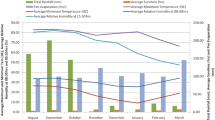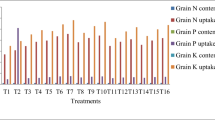Abstract
To reduce reliance on scientific fertilizer due to rapid increase of fertilizer prices and environmental constraint, it necessary to improve crop productivity and soil fertility on sustainable basses. Utilization of “summer gap” through biochar and legumes have pleasant effects on improving crop productivity and soil fertility on long term basses. Two years’ field experiments were conducted on wheat and maize crops with “summer gap” utilization with legumes and biochar at research farm of agronomy, the University of Agriculture Peshawar during 2011–2013. Wheat-maize-wheat cropping system was followed with the adjustment of legumes in “summer gap” (land available after wheat harvest till maize sowing). Legumes i. e. mung bean, cowpea and Sesbania with a fallow were adjusted in the “summer gap” with and without biochar application. Biochar was included at the rate of 0 and 50 t ha-1 with four N levels of 0, 90, 120, 150 and 0, 60, 90, 120 kg ha-1 to subsequent maize and wheat crops, respectively. In legumes’ experiment, biochar increased fresh and dry fodder yield in cowpea and Sesbania, grain and biological yields in mung bean. In maize experiments, biochar improved grain yield. Nitrogen application increased grain and biological yields. In wheat experiments with increasing nitrogen level enhanced biological and grain yields. It is concluded that use of biochar and legumes in “summer gap” improve overall farm productivity and soil fertility on sustainable basses.
Zusammenfassung
Um die Abhängigkeit von chemischen Düngern mit deren rapide steigenden Preisen und umweltbedingten Einschränkungen zu reduzieren, müssen nachhaltige Verfahren eingesetzt werden, um die Produktivität der Kulturen und die Bodenfruchtbarkeit zu steigern. Der Einsatz von Biokohle und Leguminosen im „Sommerloch“ führte zu einer langfristigen Verbesserung der Produktivität der Kulturen und der Bodenfruchtbarkeit. Im Versuchsbetrieb für Agronomie der Landwirtschaftsuniversität Peshawar wurde von 2011–2013 ein zweijähriger Feldversuch mit Weizen- und Maiskulturen durchgeführt, bei denen während des „Sommerlochs“ Leguminosen und Biokohle eingesetzt wurden. Ein Weizen-Mais-Weizen-Anbausystem wurde während des „Sommerlochs“ mit Leguminosen ergänzt (auf Parzellen, die nach der Weizenernte bis zur Maisaussaat verfügbar waren). Im „Sommerloch“ wurden Leguminosen, und zwar Mungobohnen, Schwarzaugenbohnen und Sesbania, angebaut, daneben gab es Brachflächen, und alle Flächen wurden teils mit, teils ohne Biokohle bewirtschaftet. Biokohle wurde in Gaben von 0 und 50 t ha-1, dazu Stickstoffgaben in vier Konzentrationsstärken von einerseits 0, 90, 120, 150 bzw. andererseits 0, 60, 90, 120 kg ha-1 für die jeweilig folgenden Mais- bzw. Weizenkulturen ausgebracht. Im Leguminosenversuch erhöhte die Verwendung von Biokohle den Ertrag an Frisch- und Trockenfutter bei Schwarzaugenbohnen und Sesbania, den Korn- und biologischen Ertrag bei Mungobohnen. In den Maisversuchen verbesserte Biokohle den Kornertrag. Stickstoffgaben erhöhten Korn- und biologischen Ertrag. In den Weizenversuchen führte eine höhere Stickstoffkonzentration zu besserem biologischem und Kornertrag. Daraus lässt sich schließen, dass der Einsatz von Biokohle und Leguminosen während des „Sommerlochs“ die Produktivität und Bodenfruchtbarkeit des landwirtschaftlichen Betriebs insgesamt verbessern.




Similar content being viewed by others
References
Abass MK, Jan N, Sultana Q, Ahmad SR, Rehman A (2006) Effect of different organic materials and chemical fertilizers on the yield of wheat and physical properties of soil. Sarhad J Agric 22(3):437–441
Akbar H, Ullah M, Jan MT, Jan A, Ihsanullah (2002) ield potential of sweet corn as influenced by different levels of nitrogen and plant population. Asian J Plant Sci 1(6):631–633
Arif M, Malik MA (2009) Economic feasibility of proposed cropping patterns under different moisture regimes of Pothwar plateau. Int J Agric Biol 11:27–32
Asai H, Samson BK, Stephan HM, Songyikhangsuthor K, Hommaa K, Kiyono Y, Inoue Y, Shiraiwa T, Horie T (2009) Biochar amendment techniques for upland rice production in Northern Laos. Field Crops Res 111:81–84
Aslam M, Mehmood G (2003) Economic feasibility of crop rotations under different rainfall zones. J Agric 35:27–23
Bakht J, Shafi M, Jan MT, Shah Z (2009) Influence of crop residue management, cropping system and N fertilizer on soil N and C dynamics and sustainable wheat (Triticumaestivum L.) production. Soil Tillage Res 104:233–240
Behera UK, Sharma AR, Pandey HN (2007) Sustaining productivity of wheat-soybean cropping system through integrated nutrient management practices on the Vertisols of central India. Plant Sci 297:185–199
Chalk PM (1998) Dynamics of biologically fixed N in legume-cereal rotations: a review. Aust J Agric Res 49:303–316
Chan KY, Zwieten LVI, Downie A, Joseph S (2007) Agronomic values of green waste biochar as a soil amendment. Aust J Soil Res 45:629–634
Chikowo R, Mapfumo P, Leffelaar PA, Giller KE (2006) Integrating legumes to improve N cycling on small holder farms in sub-humid Zimbabwe: resource quality, biophysical and environmental limitation. Nutr Cycl Agroecosyst 76:219–231
Danga BO, Ouma JP, Wakindiki IIC, Bartal A (2009) Legume–wheat rotation effects on residual soil moisture, nitrogen and wheat yield in tropical regions. Adv Agron 101:315–349
Glaser B, Lehmann J, Zech W (2002) Ameliorated physical and chemical properties of highly weathered soils in the tropics with charcoal. A review. Biol Fertil Soils 35:219–230
Habtegebrial K, Singh BR, Haile M (2007) Impact of tillage and nitrogen fertilization on yield, nitrogen use efficiency of tefEragrostis, Trotterand soil properties. Soil Tillage Res 94:55–63
Jan MT, Shah P, Hollington PA, Khan MJ, Sohail Q (2009) Agriculture research: design and analysis, a monograph. NWFP Agricultural University Peshawar, Peshawar
Katyal JC, Rao NH, Reddy MN (2001) Critical aspects of organic matter management in the tropics: the example of India. Nutr Cycl Agroecosyst 61:77–88
Khan A, Jan MT, Marwat KB, Arif M (2009) Organic and inorganic nitrogen treatment effect on plant and yield attributes of maize in a different tillage system. Pak J Bot 41:99–108
Kirkegaard J, Christen O, Krupinsky J, Layzell D (2008) Break crop benefits in temperate wheat production. Field Crops Res 107:185–195
Kumar K, Goh KM (2000) Crop residues and management practices: effects on soil quality, soil nitrogen dynamics, crop yield and nitrogen recovery. Adv Agron 68:197–319
Lehmann J, Rondon M (2005) Biochar Soil Management on Highly-Weathered Soils in the Humid Tropics. In: Uphoff N (Ed) Biological Approaches to Sustainable Soil Systems, CRC Press, Boca Raton, S 517–529
Lehmann J, Gaunt J, Rondon M (2006) Biochar sequestration in terrestrial ecosystems. A review. Mitig Adapt Strategies Glob Change 11(2):403–427
Liang B, Lehmann J, Solomon D, Kinyangi J, Grossman J, Oneill B, Skjemstad JO, Thies J, Luizao FJ, Petersen J, Neves EG (2006) Black carbon increases cation exchange capacity in soils. Soil Sci Soc Am J 70:1719–1730
Malhi SS, Lemke R, Wang ZH, Chhabra BS (2006) Tillage, nitrogen and crop residue effects on crop yield, nutrient uptake, soil quality, and greenhouse gas emissions. Soil Tillage Res 90:171–183
Ogola JBO, Wheerler TR, Haris PM (2002) Effect of nitrogen and irrigation on water use of maize crops. Field Crops Res 78:105–117
Ojiem JO, de Ridder N, Vanlauwe B, Giller KE (2006) Socio-ecological niche: a conceptual framework for integration of legumes in smallholder farming systems. Int J Agric Sustain 4:79–93.
Ojiem JO, Vanlauwe B, Ridder ND, Giller KE (2007) Niche based assessment of contributions of legumes to the nitrogen economy of Western Kenya smallholder farms. Plant Soil 292:119–135
Palm CA, Giller KE, Mafongoya PL, Swift MJ (2001) Management of organic matter in the tropics: translating theory into practice. Nutr Cycl Agroecosyst 61:63–75
Ramesh P, Ghosh PKA, Ramana S (2002) Effects of nitrogen on dry matter accumulation and productivity of three cropping systems and residual effects on wheat in deep vertisols of central India. J Agron Crop Sci 188(2):81–85
Shafi M, Bakht J, Jan MT, Shah Z (2007) Soil C and N dynamics and maize yield as affected by cropping system and residue management in North Western Pakistan. Soil Tillage Res 94:520–529
Shah Z, Shah SH, Peoples MB, Schwenke GD, Herridge DF (2003) Crop residue and fertilizer N effects on nitrogen fixation and yields of legume-cereal rotations and soil organic fertility. Field Crops Res 83:1–11
Singh R, Agarwal SK (2001) Growth and yield of wheat (Triticumaestivum L.) as influenced by levels of farmyard manure and nitrogen. Indian J Agron 46(3):462–467
Steiner C, Teixeira WG, Lehmann J, Nehls T, Macedo JLV, Blum WEH, Zech W (2007) Long term effects of manure, charcoal and mineral fertilization on crop production and fertility on a highly weathered Central Amazonian upland soil. Plant Soil 291:275–290
Steiner C, Glaser B, Teixeira WG, Winfried JL, Blumand EH, Zech W (2008) Nitrogen retention and plant uptake on a highly weathered central Amazonian Ferralsol amended with compost and charcoal. J Plant Nutr Soil Sci 171:893–899
Timsina J, Connor DJ (2001) The productivity and management of rice-wheat systems: issues and challenges. Field Crops Res 69:93–132
Verheijen F, Jeffery S, Bastos AC, Velde MVD, Diafas I (2004) A critical scientific review of effects on soil properties, processes and functions. Office for Official Publications of the Eur Com, Luxembourg
Yamato M, Okimori Y, Wibowo IF, Anshiori S, Ogawa M (2006) Effects of the application of charred bark of Acacia mangium on the yield of maize, cowpea and peanut, and soil chemical properties in South Sumatra, Indonesia. Soil Sci Plant Nutr 52:489–495
Yang JY, Huffman EC, Jong RD, Kirkwood V, Macdonald KB, Drury CF (2007) Residual soil nitrogen in soil landscapes of Canada as affected by land use practices and agricultural policy scenarios. Land use policy 24:89–99
Acknowledgements
I am indeed thankful to my supervisor, Dr. Muhammad Arif, Department of Agronomy, University of Agriculture, KPK Peshawar for his moral and technical support in this research study.
Author information
Authors and Affiliations
Corresponding author
Ethics declarations
Conflict of interest
F. Jalal, M. Arif, I. Ahmad and W. Murad declare that they have no competing interests.
Rights and permissions
About this article
Cite this article
Jalal, F., Arif, M., Ahmad, I. et al. Increasing Farm Productivity and Soil Fertility on Sustainable Basis Through “Summer Gap” Utilization with Biochar and Legumes. Gesunde Pflanzen 70, 45–53 (2018). https://doi.org/10.1007/s10343-017-0412-x
Received:
Accepted:
Published:
Issue Date:
DOI: https://doi.org/10.1007/s10343-017-0412-x




